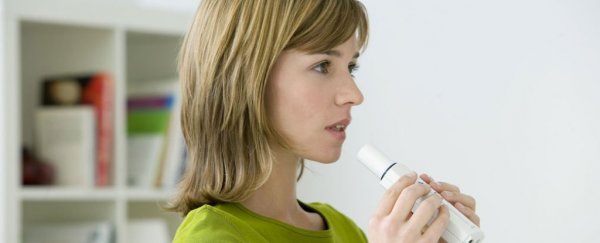For many diseases, early detection is the key to survival. But detecting the presence of a disease or infection before the symptoms present themselves can be really difficult, because where would a doctor even start? To address this problem, researchers in Korea are developing an ultrasensitive and highly selective gas sensor that can diagnose various diseases by analysing your breath.
Though that sounds pretty gross, the concept is based on the fact that our exhaled breath is filled with a bunch of chemicals called volatile organic compounds (VOCs), which can provide a smelly guidebook to your own personal health. In other words, VOCs are biomarkers that, based on their concentrations, can pinpoint certain ailments.
"For example, acetone, H2S, ammonia, and toluene can be used to evaluate diabetes, halitosis, kidney malfunction, and lung cancer, respectively, where the diagnosis of these diseases can be achieved by analysing the concentration of VOCs in exhaled breath, originating from the molecular exchange between lung tissue and blood," explains the team from the Korea Advanced Institute of Science and Technology. "Variations in the concentration of the exhaled VOCs that may serve as biomarkers for specific diseases can distinguish healthy people from those who are sick."
So, understanding how VOCs work was the first battle. Now, the researchers are working to develop a small device that can selectively analyse gases in a breath.
This new device is made up of a series of "semiconductor metal oxide-based nanofibre sensor arrays", which sounds complicated, but it's basically just an array of breathing sensors that can search for select patterns of VOCs on breath samples, and cross-check them with known diseases.
 An example of the diagnosis. Credit:KAIST
An example of the diagnosis. Credit:KAIST
This is essentially the first step in real-time diagnostics, which, when fully functional, could save countless lives. The team has been testing the device on diseases such as diabetes, lung cancer, and kidney malfunction for the past three years.
"A trace concentration of toluene (30 ppb) in exhaled breath is regarded to be a distinctive early symptom of lung cancer, which we were able to detect with our prototype breath tester," says Il-Doo Kim, the device's developer.
One of the coolest things about the new device is that it's small enough to work with things like smartphones and wearable electronic gadgets, signifying a shift away from bulky, hard-to-use medical devices and towards more portable options that are vital to those living in remote or rural areas. Not only does the small size save room in hospitals and diagnostic centres, it offers a way for people in remote areas to quickly, accurately, and inexpensively get evaluated for treatment.
Diagnosis aside, the technology could see even further use in air quality control systems. "We believe that there can be many ways to incorporate our technology based on the particular needs of industries, not just in the field of medical devices, such as detecting hazardous chemicals or gases at manufacturing factories," says Kim.
Right now, there isn't a tonne of information available on the device - likely because 'disease-sniffing' is such a competitive market right now - so we can't get too excited about its capabilities until we see some peer-reviewed, clinical studies.
But if a simple breath test can replace any number of painful, invasive, and expensive MRI, CT, blood test, endoscope, and X-ray examinations in the future, while also offering earlier diagoses, that sounds like something we all could use.
